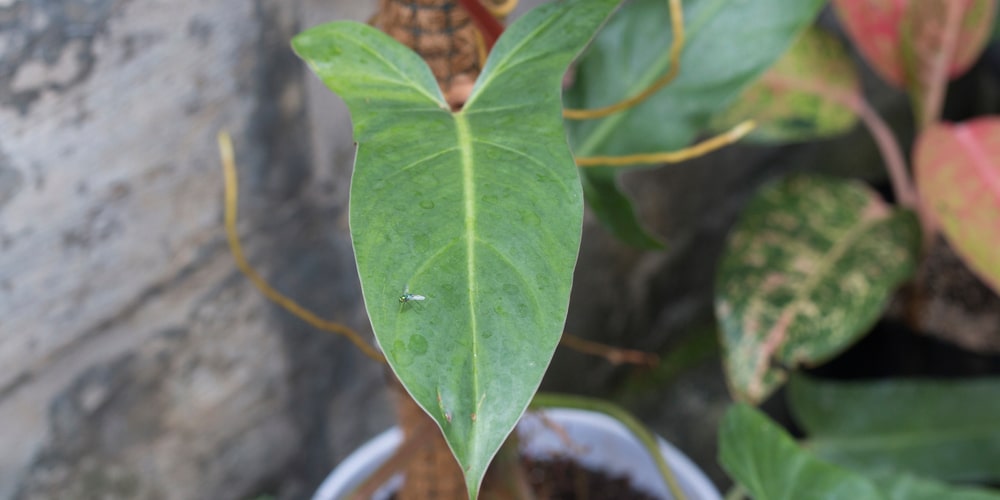Philodendron Mexicanum will grow in most homes if given the right conditions. It can also be grown outside in USDA zones 9 to 11. The Mexicanum is a fast-growing, climbing variety of philodendron with large narrow leaves. The leaves are light to dark green in color and are beautiful and glossy. New growth is produced from the center of the leaf stems. Let’s look at how to grow and care for a philodendron mexicanum.
What is a Philodendron Mexicanum?
Philodendron Mexicanum is a tropical plant in the Araceae family. It grows in the rainforest and sub-tropical regions of Central America, South America, and the Caribbean. This variety of philodendrons originates from the Chiapas region of Mexico, which is where it gets its name. It’s a tree-climbing epiphyte that grows in humid tropical areas at an elevation of about 3700 feet above sea level.
In warmer climates, the philodendron Mexianum may be planted in the ground, but protect them from extreme cold and place a thick layer of mulch around the roots during winter months. These plants produce large leaves which can grow to 2 feet long. They can grow quite tall and also spread sideways. The foliage has undersides in an attractive magenta to maroon color.
Philodendron Mexicanum is one of those plants that you will either love or hate. It can be straightforward to care for if you have high humidity, indirect light, and warm temperatures. However, the plant is poisonous, and the sap may irritate your skin; you should also be very careful when watering, pruning, or repotting. It is also toxic to animals and humans if ingested and should be kept out of reach of young children, cats, dogs and horses.
How to Care for a Philodendron Mexicanum
Philodendron Mexicanum care consists of high humidity, warm temperatures, and indirect lighting. The plant prefers daytime temperatures of 75 to 85 degrees Fahrenheit (23-29°C) and nighttime temperatures in the low 60s F (16-18°C). Avoid placing it in drafty areas near open doors, windows, or air conditioning.
Humidity
The Philodendron Mexicanum requires high humidity to grow well. If the humidity levels drop below 50 percent, the leaves will begin to turn yellow and fall off. One way to increase humidity is by placing a tray filled with pebbles and water under the plant. Check the moisture level every day or so and add water as needed. You can also put several ice cubes on top of the pebbles.
Sunlight needs
In addition to high humidity, Philodendron Mexicanum requires plenty of indirect light. A location near a window that receives bright but indirect sunlight is usually perfect. However, keep in mind that the leaves may turn yellow if the plant becomes stressed from low lighting conditions or cold drafts.
If the plant does not get enough light, new leaves will be smaller and shorter than those on a well-lit Philodendron Mexicanum.
Watering Requirements
It is best to water your plant as soon as the top 1 inch (2.5 cm) or two of potting mix begins to dry out. Overwatering can cause root rot and leaf damage. Water the plant with room-temperature water, and allow the top inch of soil to dry out between waterings.
The Philodendron Mexicanum is sensitive to fluoride in tap water; if you must use tap water, let it sit in an open container overnight so that most of the fluoride has evaporated. Alternatively, collect rainwater to water your plants.
Fertilization
Add a water-soluble houseplant fertilizer to the plant’s water once or twice a month. You can fertilize the plant according to the manufacturer’s directions.
Soil
The Philodendron Mexicanum requires nutritional soil that’s loose and well-draining. You can add some peat moss and perlite to standard houseplant soil. These plants prefer the ground to be neutral to slightly acidic, so it’s best to aim for a soil pH between 5.0 and 7.0.
Conclusion: Philodendron Mexicanum is a Great Plant
The Philodendron Mexicanum is a beautiful tropical plant that looks great in the home or office. It’s fast-growing and needs a moss pole as support. Water your plant one to three times weekly throughout the growing season. Add a diluted fertilizer to the water once monthly and place your plant in bright indirect sunlight. You can also mist your plant regularly to improve humidity.

